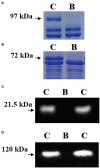Breeding of Penta Null Soybean [ Glycine max (L.) Merr.] for Five Antinutritional and Allergenic Components of Lipoxygenase, KTI, Lectin, 7S α' Subunit, and Stachyose
- PMID: 35747881
- PMCID: PMC9209763
- DOI: 10.3389/fpls.2022.910249
Breeding of Penta Null Soybean [ Glycine max (L.) Merr.] for Five Antinutritional and Allergenic Components of Lipoxygenase, KTI, Lectin, 7S α' Subunit, and Stachyose
Abstract
Soybean [Glycine max (L.) Merr.] is an excellent source of protein, oil, carbohydrates and many other bioactive ingredients for humans. However, several antinutritional and allergenic components such as lipoxygenase, KTI, lectin, 7S α' subunit, and stachyose exist in the raw mature seed. Genetic removal of these components would be the best method to improve soybean food quality. The objectives of this research were to breed a new soybean line with penta null recessive alleles (lox1/lox1/lox2/lox2/lox3/lox3-ti/ti-le/le-cgy1/cgy1-rs2/rs2) for these five components and to evaluate agronomic traits for a breeding line with penta null alleles. Seven germplasms were used to breed the penta null strain. Analysis of lipoxygenase, KTI, lectin, 7S α' subunit, and stachyose components in mature seeds was conducted by SDS-PAGE, western blot, and HPLC. One breeding line with penta null recessive alleles was developed. The breeding line has purple flowers, tawny pubescence, a determinate growth habit, and light yellow pods at maturity. The seed of the breeding line has a yellow hilum and yellow seed coat color. The stem height of the breeding line was 53.0 cm. The stachyose content of the breeding line was 2.9 g/kg. The 100-seed weight of the breeding line was 31.1 g and yield (t/ha) was 2.80. This is the first soybean strain with the penta null (lox1lox2lox3/lox1lox2lox3-ti/ti-le/le-cgy1/cgy1-rs2/rs2) genotype (free of lipoxygenase, KTI, lectin, and 7S α' subunit proteins, and with low stachyose content).
Keywords: 7S α′ subunit; KTI; lectin; lipoxygenase; penta null; stachyose.
Copyright © 2022 Choi, Ly, Lee, Oh, Kim, Kim and Chung.
Conflict of interest statement
The authors declare that the research was conducted in the absence of any commercial or financial relationships that could be construed as a potential conflict of interest.
Figures





Similar articles
-
Soybean seed lipoxygenase genes: molecular characterization and development of molecular marker assays.Theor Appl Genet. 2010 Apr;120(6):1139-49. doi: 10.1007/s00122-009-1241-9. Theor Appl Genet. 2010. PMID: 20058147
-
Genetic mapping and validation of the loci controlling 7S α' and 11S A-type storage protein subunits in soybean [Glycine max (L.) Merr.].Theor Appl Genet. 2018 Mar;131(3):659-671. doi: 10.1007/s00122-017-3027-9. Epub 2017 Dec 9. Theor Appl Genet. 2018. PMID: 29224171
-
Introgression of null allele of Kunitz trypsin inhibitor through marker-assisted backcross breeding in soybean (Glycine max L. Merr.).BMC Genet. 2016 Jul 12;17(1):106. doi: 10.1186/s12863-016-0413-2. BMC Genet. 2016. PMID: 27407019 Free PMC article.
-
Validation of Molecular Markers for Low Kunitz Trypsin Inhibitor Content in European Soybean (Glycine max L. Merr.) Germplasm.Genes (Basel). 2024 Aug 5;15(8):1028. doi: 10.3390/genes15081028. Genes (Basel). 2024. PMID: 39202388 Free PMC article.
-
Soybean genetics, genomics, and breeding for improving nutritional value and reducing antinutritional traits in food and feed.Plant Genome. 2023 Dec;16(4):e20415. doi: 10.1002/tpg2.20415. Epub 2023 Dec 12. Plant Genome. 2023. PMID: 38084377 Review.
References
-
- Chen L., Teng H., Xiao J. (2019). A value-added cooking process to improve the quality of soybean: protecting its isoflavones and antioxidant activity. Food Sci. Hum. Wellness 8, 195–201. doi: 10.1016/j.fshw.2019.05.001 - DOI
-
- Choi S. W., Chae W. G., Kang G. Y., Chung J. I. (2021). Breeding of tetra null soybean (Glycine max) for lipoxygenase, kunitz trypsin inhibitor, lectin, and 7S α′ subunit proteins. Plant Breed. 140, 123–129. doi: 10.1111/pbr.12870 - DOI
-
- Choi S. W., Han S. J., Kang D. H., Kim J. A., Lee S. J., Chung J. I. (2017). Selection of low Stachyose content of soybean line using rs2 gene marker. Korean J. Breed. Sci. 49, 318–323. doi: 10.9787/KJBS.2017.49.4.318 - DOI
-
- Chung J. I. (2014). A new soybean cultivar ‘Jinyang’: yellow soybean cultivar with Lipoxygenase 1,2,3 protein-free. Korean J. Breed. Sci. 46, 328–331. doi: 10.9787/KJBS.2014.46.3.328 - DOI
LinkOut - more resources
Full Text Sources

